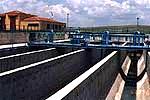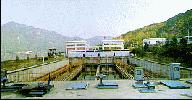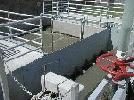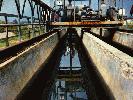
1999 © Toprak Home Page...

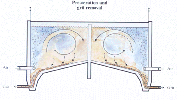
 "Centrifugal Grit Chamber"...
"Centrifugal Grit Chamber"...
| Parameters | Range | Typical |
| Detention Time (s) | 45 - 90 | 60 |
| Horizontal Velocity (ft/s) | 0.8 - 1.3 | 1.0 - 1.25 |
| Headloss in a Control Section as Percent of Depth in Channel |
30 - 40% | 36% |
| Allowance for Inlet and Outlet Turbulence | 2 Dm - max - 0.5 L | (At least 50% increase in theoretical length is
recommended ; Dm - max : depth, L : length) |
| Grit Quantities | 0.004 - 0.037 m3/1,000 m3 | - |

| Parameters | Range | Typical |
| Detention Time (Mins.) at Max. Flow | 2 - 5 | 3 |
| Depth (ft) | 7 - 16 | - |
| Length (ft) | 25 - 65 | - |
| Width (ft) | 8 - 23 | - |
| Width - Depth Ratio | 1:1 - 5:1 | 1.5 : 1 |
| Length - Width Ratio | 3:1 - 5:1 | 4:1 |
| Air Supply (ft3/min.ft of length) | 2 - 5 | - |
| Grit Quantities (ft3/mgal) | 0.5 - 27 | 2.0 |
| Parameters | Range | Typical |
| Detention Time (s) | - | 30 |
| Diameter (ft) | 4 - 24 | - |
| Height (ft) | 9 - 16 | - |
| Removal Rates (%) |
50 mesh (0.3 mm) 95+ 70 mesh (0.24 mm) 85+ 100 mesh (0.15 mm) 65+ |
- |


